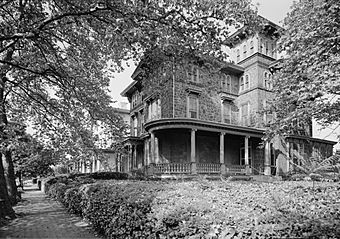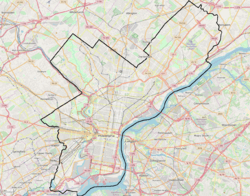Woodland Terrace, Philadelphia facts for kids
Quick facts for kids |
|
|
Woodland Terrace
|
|
 |
|
| Location | 501–519, 500–520 Woodland Ter. Philadelphia, Pennsylvania |
|---|---|
| Area | 5.4 acres (2.2 ha) |
| Built | 1861 |
| Architect | Sloan, Samuel |
| Architectural style | Italianate |
| NRHP reference No. | 72001176 |
| Added to NRHP | March 16, 1972 |
Woodland Terrace is a special street and a small neighborhood in West Philadelphia, Pennsylvania. It is known for its beautiful twin mansions. This area is so important that it was added to the National Register of Historic Places on March 16, 1972.
The street itself runs between 40th and 41st streets, connecting Baltimore Avenue to Woodland Avenue. It's a quiet, historic part of the city.
Contents
What is Woodland Terrace?
Woodland Terrace is more than just a street name. It's a neighborhood filled with unique homes. These homes are called "twin mansions" because they are semi-detached, meaning two houses share one wall. This style was popular a long time ago.
Who Designed These Homes?
The famous architect Samuel Sloan designed the houses along Woodland Terrace. He was a very busy architect in the 1800s and also designed buildings in other nearby areas.
When Was Woodland Terrace Built?
The construction of Woodland Terrace happened in 1861. A person named Charles M. S. Leslie was responsible for building these homes. They have stood for over 160 years!
Famous Residents of Woodland Terrace
Many interesting people have lived in Woodland Terrace. One notable resident was Paul Cret, a well-known architect from the 1900s. He lived at 516 Woodland Terrace for a long time while working in Philadelphia.
Why is Woodland Terrace Historic?
Woodland Terrace is considered a historic district because it has kept its original look and feel. The homes show a special type of architecture called Italianate. This style was popular in the mid-1800s and often features wide eaves, decorative brackets, and tall windows.
Being on the National Register of Historic Places means the area is recognized for its importance to American history and culture. It helps protect these special places for future generations.




